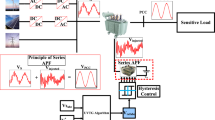Abstract
A new strategy for controlling voltage and frequency of a self-excited induction generator (SEIG) is presented. An external excitation circuit, including a power-switched inductance/capacitor, is used to compensate for the reactive demand. The conventional dynamic modeling of this system is enhanced by using an artificial neural network (ANN) to model the induction generator. The proposed ANN model is used to obtain the inverse model of the SEIG. The network is trained using the output voltage, the load and the wind turbine speed as an input vector and the required capacitor bank as the target output. The obtained inverse model is then cascaded with the SEIG. The active filter is used to replace variable capacitors and plays an important role and gives good dynamic response and robust behavior upon changes in load and generator parameters. Thus, the network combined with the active filter acts directly as a controller. Computer simulations are used to demonstrate the validity of the proposed scheme and the behavior of the SEIG for both voltage buildup and wind speed disturbance conditions.













Similar content being viewed by others
References
Farrag ME, Putrus GA (2014) Analysis of the dynamic performance of self-excited induction generators employed in renewable energy generation. J Energ. https://doi.org/10.3390/en7010278
Funabashi K (1989) On the approximate realization of continuous mappings by neural networks. Neural Netw 2(3):183–192
Hammadi NC, Ito H (1997) A learning Algorithm for Fault Tolerant Feedforward Neural Networks. IEICE Trans Inform Syst 80(1):21–27
Hilloowala RM, Sharaf AM (1996) A rule based Fuzzy Logic controller for a PWM inverter in stand alone wind energy conversion scheme. IEEE Trans Industry App 32(1):57–65
Jawabreh M, Al-Sharif L, Issa R (2015) Optimization of three-phase squirrel cage induction motor drive system using minimum input power technique. Res J Appl Sci Eng Technol 11(5):507–515
Lokriti A, Salhi I, Doubabi S, Zidani Y (2013) Induction motor speed drive improvement using Fuzzy IP-Self-Tuning Controller. A real time implementation. J Int Soc Autom (ISA-Transactions-Elsevier) 52:406–417
Premalatha K, Vasantharathna S (2015) Dynamic analysis of wind turbine driven self-excited induction generator. Res J Appl Sci Eng Technol 11(8):832–840
Wang L, Lee CH (2000) Long-shunt and short connections on dynamic performance of a SEIG feeding an induction motor load. IEEE Trans Energy Conv 15(1):1–7
Zidani Y, Naciri M (2001a) A numerical analytical approach for the optimal capacitor used for the self excited induction generator. In: 32nd IEEE PESC power electronics specialists conference, Vancouver, Canada, pp 216–220
Zidani Y, Naciri M (2001b) A steady state analysis of the self-excited induction generator controlled by an electronic load governor. In: 4th IEEE PEDS power electronics and drive systems, Indonesia, pp 903–907
Zouggar S, Zidani Y, ELhafyani ML, Ouchbel T, Seddik M, Oukili M (2012) Neural control of the self-excited induction generator for variable-speed wind turbine generation. In: sustainability in energy and buildings, smart innovation, systems and technologies, Springer, Berlin, Volume 12, pp 213–223. doi: https://doi.org/10.1007/978-3-642-27509-8_17
Author information
Authors and Affiliations
Corresponding author
Appendix
Appendix
IG parameters: 3 kW, 380 V, 4poles, 1500 rpm, R s = 1.1 Ω, R r = 6.5 Ω, L s = L r = 8.511 mH, C = 120 μF
Parameters of the active filter: L f = 0.0051 H, C f = 2000 μF, R f = 80 Ω, r = 1 Ω (Fig. 14)
Rights and permissions
About this article
Cite this article
Zidani, Y., Zouggar, S. & Elbacha, A. Steady-State Analysis and Voltage Control of the Self-Excited Induction Generator Using Artificial Neural Network and an Active Filter. Iran J Sci Technol Trans Electr Eng 42, 41–48 (2018). https://doi.org/10.1007/s40998-017-0046-0
Received:
Accepted:
Published:
Issue Date:
DOI: https://doi.org/10.1007/s40998-017-0046-0





